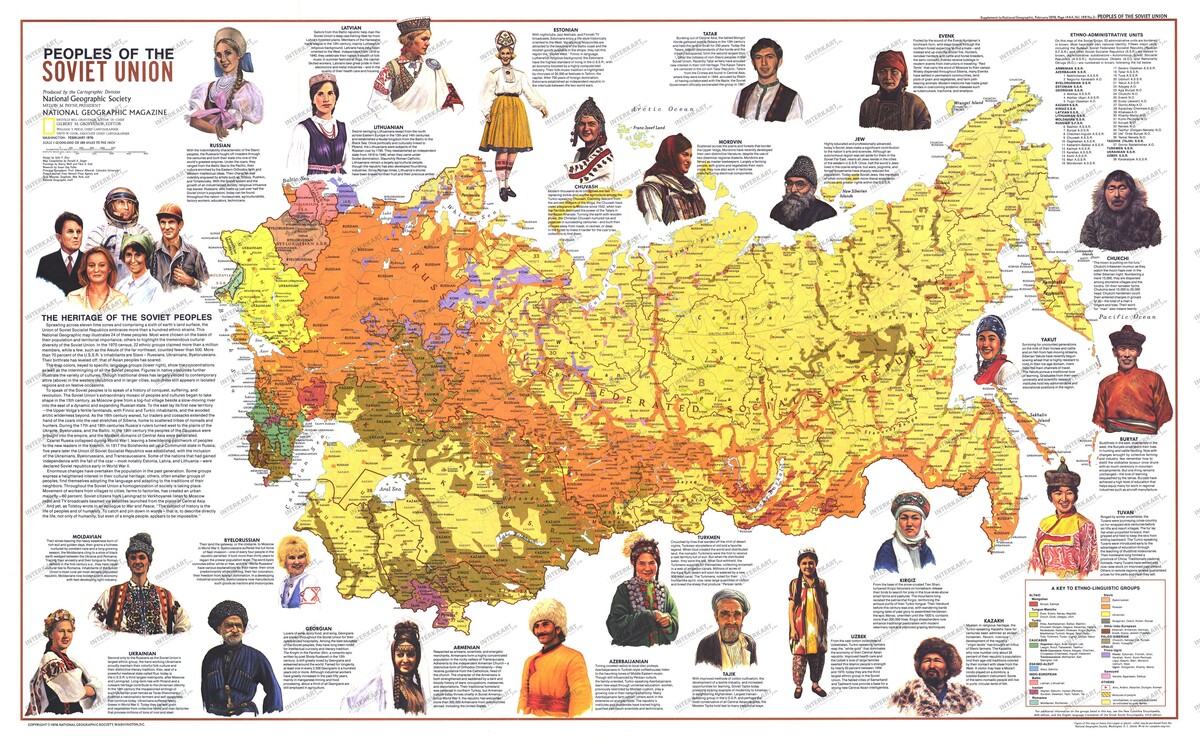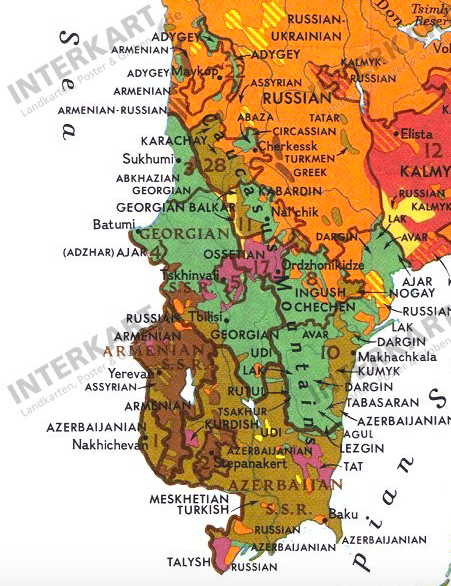
I came across this fascinating map (link to full-sized map) of the “People’s of the Soviet Union”, published by the National Geographic Magazine in February 1976, which offers a unique view into what the West thought of us, the Soviet’s at that time (and I wasn’t even born then).
The map illustrates 24 of these peoples, most of them chosen on the basis of their population and territorial importance, others to highlight the tremendous cultural diversity of the Soviet Union.

Note how Karabakh is separated from Azerbaijan’s territory. Also, there is a prevalence of Armenians in Georgia’s Javakheti and Abkhazia regions, as well as coastal areas of Russia’s Black See region. Below is the extract about Armenians:
Respected artisans, scientists, and energetic merchants, Armenians form a highly concentrated population in the rocky valleys of Transcaucasia.
Adherents to the independent Armenian Church – a distinctive form of Orthodox Christianity – they receive guidance from the Catholicos, head of the church.
The character of the Armenians is both strengthened and saddened by a dark and bloody history of wars, occupations, massacres, and deportations.
Their traditional homeland was centered in northern Turkey, but Armenian culture today thrives chiefly in Soviet Armenia.
Since World War II, the republic has welcomed more than 200,000 Armenians from communities abroad, including the United States.
Below is also the full text description published with the map.
Sprawling across eleven time zones and comprising a sixth of earth’s land surface, the Union of Soviet Socialist Republics embraces more than a hundred ethnic strains. This National Geographic map illustrates 24 of these peoples. Most were chosen on the basis of their population and territorial importance, others to highlight the tremendous cultural diversity of the Soviet Union. In the 1970 census, 22 ethnic groups claimed more than a million members, while a few, such as the Aleuts of the far northeast, counted fewer than 500. More than 70 percent of the U.S.S.R.’s inhabitants are Slavs – Russians, Ukrainians, Byelorussians. Their birthrate has leveled off; that of Asian peoples has soared.
The map colors, keyed to specific language groups (lower right), show the concentrations as well as the intermingling of all the Soviet peoples. Figures in native costumes further illustrate the variety of cultures. Though traditional dress has largely yielded to contemporary attire (above) in the western republics and in larger cities, such dress still appears in isolated regions and on festive occasions.
To speak of the Soviet peoples sis to speak of a history of conquest, suffering, and revolution. The Soviet Union’s extraordinary mosaic of peoples and cultures began to take shape in the 15th century, as Moscow grew from a log-hut village beside a slow-moving river into the seat of a a dynamic and expanding Russian state. The east lay its first new territory into the seat of a dynamic and expanding Russian state. To the east lay its first new territory – the Upper Volga’s fertile farmlands, with Finnic and Turkic inhabitants, and the wooded arctic wilderness beyond. As the 16th century waned, fur traders and cossacks extended the hand of the czars into the vast stretches o Siberia, home to scattered tribes of nomads and hunters. During the 17th and 18th centuries Russia’s rulers turned west to the plains of the Ukraine, Byelorussia, and the Baltic. In the 19th century the peoples of the Caucasus were brought into the empire, and the Moslem domains of Central Asia were penetrated.
Czarist Russia collapsed during World war I, leaving the bewildering patchwork of peoples to the new leaders in the Kremlin. In 1917 the Bolsheviks set up a Communist state in Russia; five years later the Union of Soviet Socialist Republics was established, with the inclusion of the Ukrainians, Byelorussians, and Transcaucasians. Some of the nations that had gained independence with the fall of the czar – most notably Estonia, Latvia, and Lithuania – were declared Soviet republics early in the World War II.
Enormous changes have overtaken the population in the past generation. Some groups express a heightened interest in their cultural heritage; others, often smaller groups of peoples, find themselves adopting the language and adapting to the traditions of their neighbors. Throughout the Soviet Union a homogenization of society is taking place. Movement of workers from villages to cities, farms to factories, has created an urban majority – 60 percent. Soviet citizens from Leningrad to Verkhoyansk listen to Moscow radio and TV broadcasts beamed via satellites launched from the plains of Central Asia.
And yet, as Tolstoy wrote in an epilogue to War and Peace, “The subject of history is the life of peoples and of humanity. To catch and pin down in words – that is, to describe directly the life, not only of humanity, but even of a single people, appears to be impossible.”
Source: Reddit Armenia